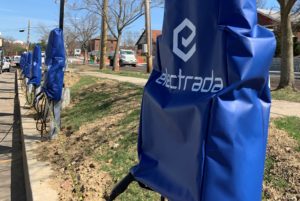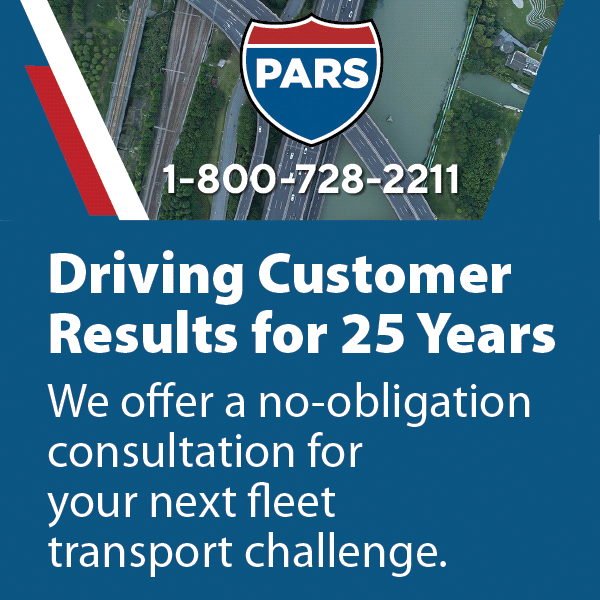
By Ed Pierce, Contributing Editor
March 27, 2022
The new partnership of Holman and Electrada presents a major step forward for fleets transitioning towards electrification. Holman, which provides fleet management services to corporate, government, and utility fleets, recently announced a partnership with Electrada, who designs, builds, owns, operates, and maintains EV charging infrastructure. Their partnership will help companies that operate fleets make a seamless transition to electric vehicles in a way that provides reliable service and simplified fueling costs.
The successful transition from internal combustion engine (ICE) vehicles to EVs involves much more than selecting vehicles. Of equal importance is a focus on infrastructure, namely the power needs, charging locations, and reliable operation of charging stations. This adds quite a few new factors beyond the ICE costs that most fleet managers are familiar with. By partnering with Electrada, Holman will be able to ease the transition for their customers and help them meet their corporate sustainability goals.
In order to get more information about the new partnership between Electrada and Holman, we sat down with two of the top leaders from both organizations. Emily Graham is the Director of Sustainability at Holman while Kevin Kushman is the CEO of Electrada. They answered a variety of questions about their new partnership and what their thoughts were of the general shift towards electrification among fleets.
Here are a few of the questions we had answered:
Tell us about Electrada and your decision to partner with Holman.
 Kevin Kushman talked about the various complexities associated with transitioning to EVs and often a lack of a cohesive approach which makes it much more challenging for fleet owners to adopt EVs at scale. With the landscape of this segment of the industry rapidly evolving, it’s difficult for fleet operators to feel confident about switching from petroleum-based fuel to power, which is a completely different environment. He also talked about the difficulty to make the switch within a range of prices that allow everyone to lock in savings and remove volatility from the process. This gap was part of what led to the founding of Electrada and the new partnership with Holman.
Kevin Kushman talked about the various complexities associated with transitioning to EVs and often a lack of a cohesive approach which makes it much more challenging for fleet owners to adopt EVs at scale. With the landscape of this segment of the industry rapidly evolving, it’s difficult for fleet operators to feel confident about switching from petroleum-based fuel to power, which is a completely different environment. He also talked about the difficulty to make the switch within a range of prices that allow everyone to lock in savings and remove volatility from the process. This gap was part of what led to the founding of Electrada and the new partnership with Holman.
According to Kushman, Electrada was founded by experts with backgrounds in utilities, energy technology, software development, analytics, and mobility. Together, they’re able to integrate technologies and strategies that are often isolated throughout the process to provide a holistic solution. Electrada shifts these risks from fleet owners by owning and operating the EV charging infrastructure under a performance contract with the fleet owner. They’ve worked to provide reliable charging at a reasonable price to counties, municipalities, and companies across the country. Now, the partnership with Holman has been an opportunity for Electrada to engage fleet operators.
Electrada has been drawn into several large fleet electrification programs, but it’s a fragmented and emerging marketplace. As the EV marketplace continues to mature, it is still fragmented and there are many questions among fleet managers about the gear involved in transitioning to EVs, but there hasn’t been as much discussion about the energy side of things. The third leg of the TCO stool is the cost of fueling, for which Electrada offers an innovative solution. Electrada is able to offer fleet operators Charging-as-a-service for fueling EVs at a fixed, predictable price, further simplifying the transition to electrification.
You mention unprecedented market demand for a comprehensive and seamless approach to electrification. How fast are we moving in this transition? How fast are fleets moving into EVs?
 According to Emily Graham, conversations around holistic sustainability strategies have ramped-up considerably in the last 12-18 months. She noted two scenarios that typically drive these conversations: one is the desire to move toward a goal of structured organizational stability, while the other is uncertainty around the logistics of incorporating EVs. According to Graham, these conversations should primarily focus on what the goal is of transitioning towards electric vehicles as well as educating various stakeholders on what building the fueling infrastructure will look like.
According to Emily Graham, conversations around holistic sustainability strategies have ramped-up considerably in the last 12-18 months. She noted two scenarios that typically drive these conversations: one is the desire to move toward a goal of structured organizational stability, while the other is uncertainty around the logistics of incorporating EVs. According to Graham, these conversations should primarily focus on what the goal is of transitioning towards electric vehicles as well as educating various stakeholders on what building the fueling infrastructure will look like.
Are there specific vertical markets that are ahead of the curve?
Graham stated that while there was no specific vertical taking the lead on embracing EVs, the pharmaceutical, manufacturing, rail, and utility markets are all ahead of the curve with many organizations across these sectors exploring EVs and thinking strategically about the use of energy. By fueling large populations of vehicles at a single depot location, fleets can better meet their corporate emissions goals.
Kushman identified the emergence of use cases up and down the vehicle class array. While fleet managers started with light and medium-duty vehicles due to the price proximity to EVs and their ability to support a wide range of fleet applications, he noted that companies are also now exploring transitioning heavy-duty vehicles to electrification. Several large, nationwide fleet operators have plans in place to transition the majority of their vehicles to electric models in the coming years, which enables Electrada and Holman to come up with a replacement strategy for the entire vehicle array based on location and intended job role.
How did the relationship between Holman and Electrada begin?
The relationship between Electrada and Holman stretches back almost three years. Graham stated that the relationship began as a business development contact from a fleet perspective, but Holman was able to find more opportunities to collaborate and work together on additional opportunities.
Kushman added that the relationship has transitioned to a bundled approach where they leverage Holman’s customer portal as a single platform to provide solution/price per vehicle per month/price bundled per mile at a time to delineate the cost. This creates an integrated solution that mitigates risk and makes it easy for fleet managers to understand and transition. The end result is a simple, multi-year relationship that matches the way fleet owners currently acquire and work their way through vehicles and doesn’t require them to be the system integrator.
On Electrada’s side, they guarantee a 99%+ performance up time for the system. They’ll financially backstop the price and reliability, which no other company is currently doing. Instead of asking the fleet owner to burden the performance and energy risk, Electrada will push the intelligence and operational reliability to the edge where the vehicles are parked and is the stakeholder responsible for providing reliable electric fueling.
What are the financial hurdles fleet managers face when getting started with a transition?
Graham discussed the hurdle facing fleet managers who have never before had to think about additional cost beyond the cost of acquiring a vehicle. In addition to the cost of EVs, there’s also capital funding needed for infrastructure requirements, which typically becomes a facilities or sustainability project and introduces new stakeholders. Additionally, fleet operators have to face energy risk that can cause significant demand charges and outages that could shut down a portion of the grid.
Thanks to the new partnership, Electrada can appropriate the use of energy for the fleet and alleviate the customer from needing to think about demand charges, time of day load profiles, or grid constraints. They will deliver all of the data to provide customers with a single stream billing solution. That way customers can easily determine the cost per mile for fuel. This simplifies the transition and makes it easier to compare it to current costs of operating the fleet.
Which fleet types or profiles are leading the way in transitioning to EVs?
Graham talked about two different profiles — the first profile describes fleets whose vehicles come back to a single location for a period of time that allows for a centralized charging solution. A centralized charging depot is often a more complex undertaking, and fleets recognize that they cannot manage the project alone.
She noted that most fleet operators don’t typically solve how they’re getting energy from the outset of an EV program. They simply assume that they can just use a fuel management provider for example. When charging an EV in the wild, however, there is no way to manage cost.
Kushman added that relying on public infrastructure to charge vehicles could result in high levels of downtime, as drivers may have to wait to use chargers or drive around looking for an available charging station. With an Electrada depot solution, fleet managers are assured that their vehicles are using the exact power that’s managed, allowing them to collect data, conduct analytics, and mitigate downtime.
How have EVs and electronic charging impacted your fuel cost analysis?
According to Graham, the life cycle cost analysis of the vehicle now takes into account the cost of charging as well as the useful life of the battery. The team has reworked the calculation to have a full evaluation in terms of energy versus fuel cost so fleet operators can easily assess a unit’s TCO as they evaluate a potential transition to EVs.
 Will the fleet management companies finance the infrastructure as well as the vehicles when it comes to EVs?
Will the fleet management companies finance the infrastructure as well as the vehicles when it comes to EVs?
Holman has a long history of providing leasing and financial support for customers on the vehicle side. Additionally, Kushman stated that one of the reasons they founded Electrada was because they felt that the traditional procurement approach for fleet electrification wasn’t an apples-to-apples equipment purchase but rather a fuel transition strategy, so Electrada looked at capitalizing these outcomes for customers to deliver predictable energy costs and mitigate electricity price volatility.
The result is that Electrada can reduce the burden for the fleet owner through the cost per kilowatt hour, shown as a fuel charge. This makes it easier for fleet managers to calculate costs.
How does a fleet manager begin the conversation about transitioning to EVs?
Graham states that Holman typically starts a conversation by addressing the disjointed patchwork of various fleet management, energy, sustainability, operations, and charging infrastructure stakeholders across an organization. To bring order to this patchwork, fleet managers must start their journey with intention.
Holman recommends and helps an organization set targets and goals, prioritizing locations where they could potentially set up depots. Then they think about the vehicles that would go there and the jobs they would do, focusing on vehicle fit, charging fit, and driver fit to create a path to electrification.
Holman recommends taking a phased approach towards electrification, which allows fleet customers to gradually learn and expand. By taking the transition slowly, a fleet can learn things like the ease of transitioning by region of the country, accessibility to electricity, intended vehicle role, and even climate. These factors can play into the use of battery energy and help guide subsequent phases in the transition.
Final thoughts for fleet managers
Kushman brought up the need to consider the energy component of the decision at the same time as thinking about vehicles and use cases. If people don’t consider the energy until the end, they may end up choosing the cheapest piece of equipment, sacrificing performance, reliability, and preventing effective scaling of electrification.
The cheapest charger could then lead to buyer’s remorse regarding the long-term TCO. He also noted that fleet managers should demand performance guarantees from the people providing charging services or systems.
Graham concluded the session by stressing the importance of fleet managers being intentional about their goal in transitioning to EVs. Thanks to their partnership with Electrada, the Holman solution can simplify the experience, reliably delivering energy and reducing downtime applied to the fleet.



